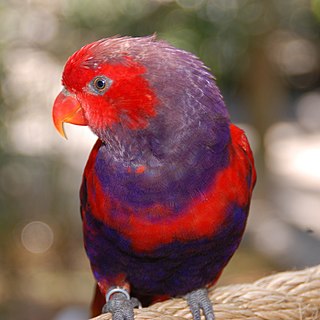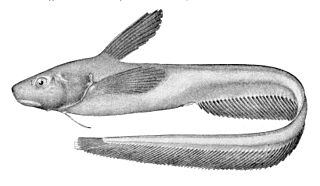
The International Union for Conservation of Nature (IUCN) Red List of Threatened Species, also known as the IUCN Red List or Red Data Book, founded in 1964, is an inventory of the global conservation status and extinction risk of biological species. A series of Regional Red Lists, which assess the risk of extinction to species within a political management unit, are also produced by countries and organizations.

Podocarpus totara (; the tōtara is a species of podocarp tree endemic to New Zealand. It grows throughout the North Island, South Island and rarely on Stewart Island/Rakiura in lowland, montane and lower subalpine forest at elevations of up to 600 m.

The little tern is a seabird of the family Laridae. It was formerly placed into the genus Sterna, which now is restricted to the large white terns. The genus name is a diminutive of Sterna, 'tern'. The specific albifrons is from Latin albus, 'white', and frons, 'forehead'. The former North American and Red Sea S. a. saundersi subspecies are now considered to be separate species, the least tern and Saunders's tern.

The dingiso, also known as the bondegezou or bakaga, is an endangered, long-tailed marsupial found only in mountain forests on the west of the island of New Guinea. It is a species of tree-kangaroo, which are mammals native to Australia and New Guinea that feed on leaves or other plant matter. It belongs to the macropodid family (Macropodidae) with kangaroos, and carries its young in a pouch like most other marsupials. Though sacred to the local Moni people, it is still threatened by hunting and habitat loss.

The tropical mockingbird is a resident breeding bird from southern Mexico to northern and eastern South America and in the Lesser Antilles and other Caribbean islands.

The least tern is a species of tern that breeds in North America and locally in northern South America. It is closely related to, and was formerly often considered conspecific with, the little tern of the Old World. Other close relatives include the yellow-billed tern and Peruvian tern, both from South America.

The Puerto Rican woodpecker is the only woodpecker endemic to the archipelago of Puerto Rico and is one of the five species of the genus Melanerpes that occur in the Antilles. Furthermore, it is the only resident species of the family Picidae in Puerto Rico. The species is common on the main island of Puerto Rico and rare on the island of Vieques.

The Puerto Rican flycatcher is a tyrant flycatcher endemic to the Puerto Rican archipelago and one of the 22 species belonging to the genus Myiarchus of the family Tyrannidae.

An IUCN Red List Critically Endangered species is one that has been categorized by the International Union for Conservation of Nature as facing an extremely high risk of extinction in the wild. As of December 2023, of the 157,190 species currently on the IUCN Red List, 9,760 of those are listed as Critically Endangered, with 1,302 being possibly extinct and 67 possibly extinct in the wild.

Zombia antillarum, commonly known as the zombie palm, is a species of palm tree and the only member of the genus Zombia. It is endemic to the island of Hispaniola in the Greater Antilles. Usually found in dry, hilly areas of northern and southern Haiti and the northwest of the Dominican Republic, Z. antillarum is a relatively short fan palm with clustered stems and a very distinctive appearance caused by its persistent spiny leaf sheaths. Threatened by habitat destruction in Haiti, Z. antillarum is a popular ornamental species due to its distinctive appearance, low maintenance requirements and salt tolerance.

The Sunda scops owl is a small brown owl native to the Sunda Islands.

A species that is extinct in the wild (EW) is one that has been categorized by the International Union for Conservation of Nature as only consisting of living members kept in captivity or as a naturalized population outside its historic range. Classification requires exhaustive surveys conducted within the species' known habitat with consideration given to seasonality, time of day, and life cycle. Once a species is classified as EW, the only way for it to be downgraded is through reintroduction.

The Manchurian bush warbler, also known as Korean bush warbler, is a bird in the family Cettiidae. The species was first described by Robert Swinhoe in 1860. It is found in northeastern China.

Eos is a genus of parrots belonging to the lories and lorikeets tribe of the family Psittaculidae. There are six species which are all endemic to islands of eastern Indonesia, most within very restricted ranges. They have predominantly red plumage with blue, purple or black markings. Males and females are similar in appearance.

Oryzomys antillarum, also known as the Jamaican rice rat, is an extinct rodent of Jamaica. A member of the genus Oryzomys within the family Cricetidae, it is similar to O. couesi of mainland Central America, from where it may have dispersed to its island during the last glacial period. O. antillarum is common in subfossil cave faunas and is also known from three specimens collected live in the 19th century. Some historical records of Jamaican rats may pertain to it. The species probably became extinct late in the 19th century, perhaps due to the introduction of the small Indian mongoose, competition with introduced rodents such as the brown rat, and habitat destruction.

Ijimaia is a genus of jellynose fishes, one of four in the order Ateleopodiformes.
Anacropora matthai is a species of briar coral in the family Acroporidae. This species is found in the Central Indo-Pacific in waters off Solomons, Japan, East China Sea, Eastern Australia, Fiji, Palau, and Pohnpei in shallow tropical reef environments, in depths of 8 to 20 m. The species is named after George Matthai.
Ijimaia dofleini, often called the Ô-shachiburi in Japanese, is a species of ray-finned fish within the family Ateleopodidae. The species is known from four localities in the Pacific Ocean. These localities were in marine waters of the Sagami Sea, Ryuku Islands, Taiwan, and Society Islands at depths of 300 to 500 meters, living near benthopelagic environments on outer continental shelfs and slopes. The species can grow up to lengths of 124 to 170 centimeters. It has been assessed as 'Data deficient' by the IUCN Red List in 2018 due to there being limited information on its distribution, population, and ecology.















